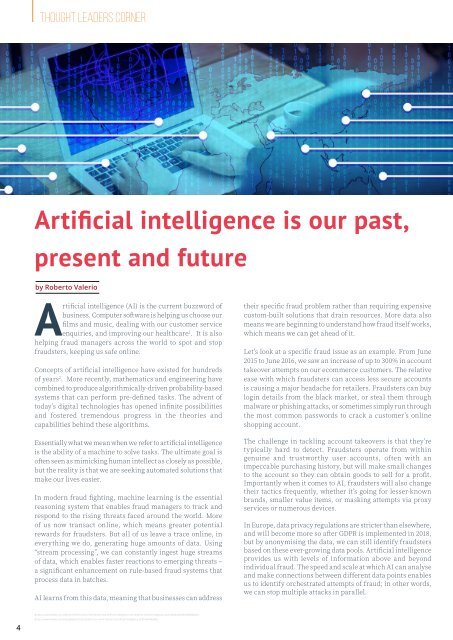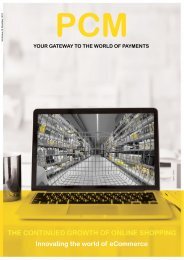PCM vol. 3 Issue 8
The eighth issue of the Payments & Cards eMagazine \"PCM\". In this issue, we look at the increasingly important role of data and analytics in the FinTech & Payments industry. Contributions from Adyen, Risk Ident, Travix, TruRating, NORTHSTAR Innovation Group, AEVI, Market Pay, nexo Standards & Netflix.
The eighth issue of the Payments & Cards eMagazine \"PCM\". In this issue, we look at the increasingly important role of data and analytics in the FinTech & Payments industry. Contributions from Adyen, Risk Ident, Travix, TruRating, NORTHSTAR Innovation Group, AEVI, Market Pay, nexo Standards & Netflix.
Create successful ePaper yourself
Turn your PDF publications into a flip-book with our unique Google optimized e-Paper software.
Thought Leaders Corner<br />
Artificial intelligence is our past,<br />
present and future<br />
by Roberto Valerio<br />
Artificial intelligence (AI) is the current buzzword of<br />
business. Computer software is helping us choose our<br />
films and music, dealing with our customer service<br />
enquiries, and improving our healthcare 1 . It is also<br />
helping fraud managers across the world to spot and stop<br />
fraudsters, keeping us safe online.<br />
Concepts of artificial intelligence have existed for hundreds<br />
of years 2 . More recently, mathematics and engineering have<br />
combined to produce algorithmically-driven probability-based<br />
systems that can perform pre-defined tasks. The advent of<br />
today’s digital technologies has opened infinite possibilities<br />
and fostered tremendous progress in the theories and<br />
capabilities behind these algorithms.<br />
Essentially what we mean when we refer to artificial intelligence<br />
is the ability of a machine to solve tasks. The ultimate goal is<br />
often seen as mimicking human intellect as closely as possible,<br />
but the reality is that we are seeking automated solutions that<br />
make our lives easier.<br />
In modern fraud fighting, machine learning is the essential<br />
reasoning system that enables fraud managers to track and<br />
respond to the rising threats faced around the world. More<br />
of us now transact online, which means greater potential<br />
rewards for fraudsters. But all of us leave a trace online, in<br />
everything we do, generating huge amounts of data. Using<br />
“stream processing”, we can constantly ingest huge streams<br />
of data, which enables faster reactions to emerging threats –<br />
a significant enhancement on rule-based fraud systems that<br />
process data in batches.<br />
AI learns from this data, meaning that businesses can address<br />
their specific fraud problem rather than requiring expensive<br />
custom-built solutions that drain resources. More data also<br />
means we are beginning to understand how fraud itself works,<br />
which means we can get ahead of it.<br />
Let’s look at a specific fraud issue as an example. From June<br />
2015 to June 2016, we saw an increase of up to 300% in account<br />
takeover attempts on our ecommerce customers. The relative<br />
ease with which fraudsters can access less secure accounts<br />
is causing a major headache for retailers. Fraudsters can buy<br />
login details from the black market, or steal them through<br />
malware or phishing attacks, or sometimes simply run through<br />
the most common passwords to crack a customer’s online<br />
shopping account.<br />
The challenge in tackling account takeovers is that they’re<br />
typically hard to detect. Fraudsters operate from within<br />
genuine and trustworthy user accounts, often with an<br />
impeccable purchasing history, but will make small changes<br />
to the account so they can obtain goods to sell for a profit.<br />
Importantly when it comes to AI, fraudsters will also change<br />
their tactics frequently, whether it’s going for lesser-known<br />
brands, smaller value items, or masking attempts via proxy<br />
services or numerous devices.<br />
In Europe, data privacy regulations are stricter than elsewhere,<br />
and will become more so after GDPR is implemented in 2018,<br />
but by anonymising the data, we can still identify fraudsters<br />
based on these ever-growing data pools. Artificial intelligence<br />
provides us with levels of information above and beyond<br />
individual fraud. The speed and scale at which AI can analyse<br />
and make connections between different data points enables<br />
us to identify orchestrated attempts of fraud; in other words,<br />
we can stop multiple attacks in parallel.<br />
1 https://www.forbes.com/sites/jenniferhicks/2017/05/16/see-how-artificial-intelligence-can-improve-medical-diagnosis-and-healthcare/#1bb649e86223<br />
4<br />
2 https://www.forbes.com/sites/gilpress/2016/12/30/a-very-short-history-of-artificial-intelligence-ai/#74ab649a6fba

















